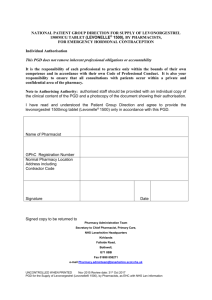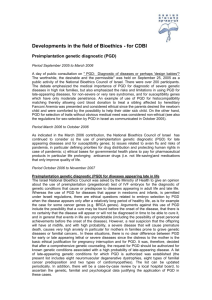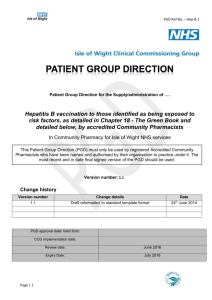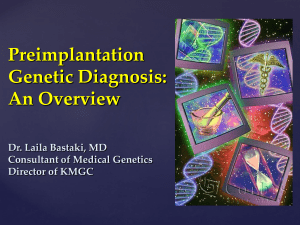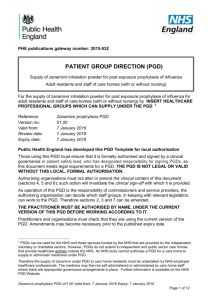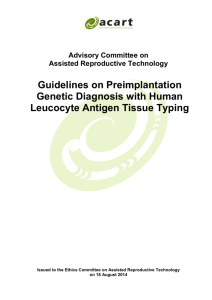Zanamivir inhalation powder for the treatment of influenza
advertisement
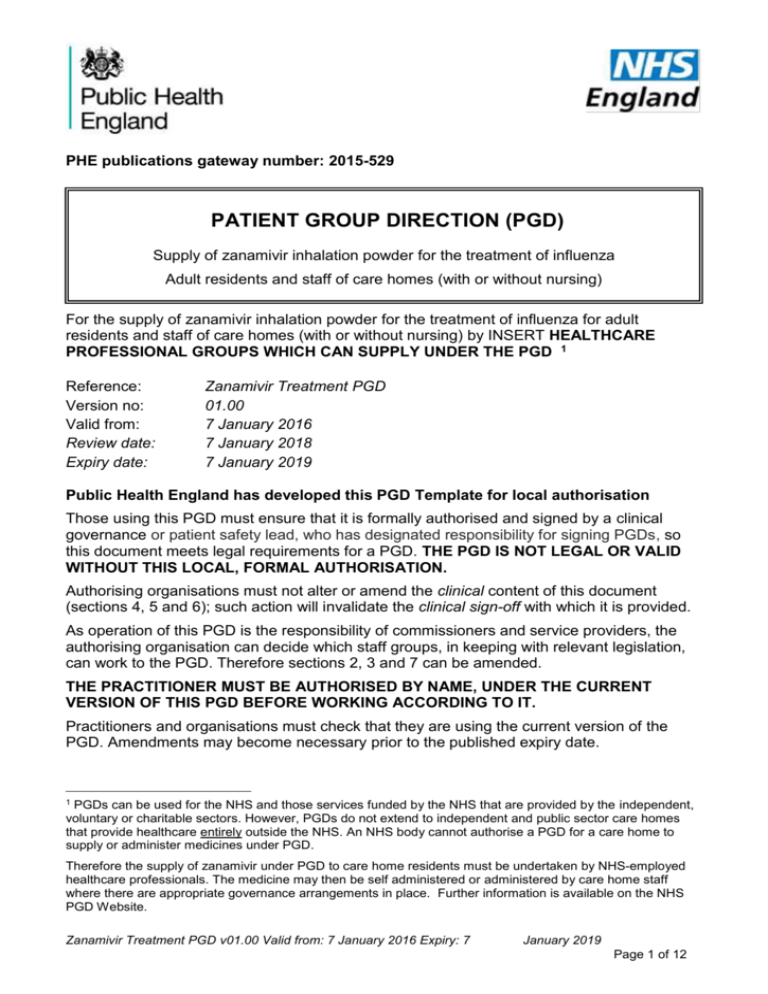
PHE publications gateway number: 2015-529 PATIENT GROUP DIRECTION (PGD) Supply of zanamivir inhalation powder for the treatment of influenza Adult residents and staff of care homes (with or without nursing) For the supply of zanamivir inhalation powder for the treatment of influenza for adult residents and staff of care homes (with or without nursing) by INSERT HEALTHCARE PROFESSIONAL GROUPS WHICH CAN SUPPLY UNDER THE PGD 1 Reference: Version no: Valid from: Review date: Expiry date: Zanamivir Treatment PGD 01.00 7 January 2016 7 January 2018 7 January 2019 Public Health England has developed this PGD Template for local authorisation Those using this PGD must ensure that it is formally authorised and signed by a clinical governance or patient safety lead, who has designated responsibility for signing PGDs, so this document meets legal requirements for a PGD. THE PGD IS NOT LEGAL OR VALID WITHOUT THIS LOCAL, FORMAL AUTHORISATION. Authorising organisations must not alter or amend the clinical content of this document (sections 4, 5 and 6); such action will invalidate the clinical sign-off with which it is provided. As operation of this PGD is the responsibility of commissioners and service providers, the authorising organisation can decide which staff groups, in keeping with relevant legislation, can work to the PGD. Therefore sections 2, 3 and 7 can be amended. THE PRACTITIONER MUST BE AUTHORISED BY NAME, UNDER THE CURRENT VERSION OF THIS PGD BEFORE WORKING ACCORDING TO IT. Practitioners and organisations must check that they are using the current version of the PGD. Amendments may become necessary prior to the published expiry date. 1 PGDs can be used for the NHS and those services funded by the NHS that are provided by the independent, voluntary or charitable sectors. However, PGDs do not extend to independent and public sector care homes that provide healthcare entirely outside the NHS. An NHS body cannot authorise a PGD for a care home to supply or administer medicines under PGD. Therefore the supply of zanamivir under PGD to care home residents must be undertaken by NHS-employed healthcare professionals. The medicine may then be self administered or administered by care home staff where there are appropriate governance arrangements in place. Further information is available on the NHS PGD Website. Zanamivir Treatment PGD v01.00 Valid from: 7 January 2016 Expiry: 7 January 2019 Page 1 of 12 Change history Version number 01.00 Change details Date Original PGD template developed 7 January 2016 Zanamivir Treatment PGD 01.00 Valid from: 7 January 2016 Expiry: 7 January 2019 Page 2 of 12 1. PGD template development This PGD template has been developed by the following on behalf of Public Health England: Developed by: Name Pharmacist (Lead author) Jacqueline Lamberty Doctor Registered nurse Signature Pharmacy and Medicines Management Lead Date 7 January 2016 Dr Gavin Dabrera Interim Lead, Legionella and Influenza Preparedness Section, PHE Respiratory Diseases Department 7 January 2016 María Saavedra-Campos Senior Epidemiology Scientist; Field Epidemiology Service SEaL National Infection Service 7 January 2016 This PGD template has been peer reviewed by an expert panel in accordance with the PHE PGD Policy. It has been agreed by the PHE Medicines Management Group and the PHE Clinical Governance Group. Expert panel Name Designation Dr Richard Pebody Chair, Head PHE Respiratory Disease Department Mr Phillip Howard Consultant Pharmacist, Leeds Teaching Hospitals NHS Trust Mr Mark Borthwick Consultant Pharmacist, Oxford University Hospitals NHS Trust Dr Mat Donati Consultant Medical Virologist, Bristol PHE laboratory Dr Sally Millership CCDC, East of England PHEC Zanamivir Treatment PGD 01.00 Valid from: 7 January 2016 Expiry: 7 January 2019 Page 3 of 12 2. Organisational authorisations The PGD is not legally valid until it has had the relevant organisational authorisation. It is the responsibility of the organisation that has legal authority to authorise the PGD, to ensure that all legal and governance requirements are met. The authorising body accepts governance responsibility for the appropriate use of the PGD. INSERT AUTHORISING BODY NAME authorises this PGD for use by the services or providers listed below: Authorised for use by the following organisations and/or services Limitations to authorisation eg Any local limitations the authorising organisation feels they need to apply in-line with the way services are commissioned locally. This organisation does not authorise the use of this PGD by …. Organisational approval (legal requirement) Role Name Complete eg NHSE Governance Lead, Medical Director Sign Additional signatories according to locally agreed policy Role Name Sign Date Date Organisations must add an individual practitioner authorisation sheet or list of authorised practitioners. This varies according to local policy but this should be a signature list or an individual agreement as included at the end of this PGD. Zanamivir Treatment PGD 01.00 Valid from: 7 January 2016 Expiry: 7 January 2019 Page 4 of 12 3. Characteristics of staff Qualifications and professional registration To be completed by the organisation authorising the PGD eg: Registered professional with one of the following bodies: Nurses currently registered with the Nursing and Midwifery Council (NMC). Pharmacists currently registered with the General Pharmaceutical Council (GPhC). Additional registered healthcare professionals to be added by organisation authorising the PGD Additional requirements Additionally practitioners: must be authorised by name as an approved practitioner under the current terms of this PGD before working to it must have undertaken appropriate training for working under PGDs for supply/administration of medicines must be competent in the use of PGDs (see NICE Competency framework for health professionals using Patient Group Directions) must be familiar with the product and alert to changes in the Summary of Product Characteristics must have access to the PGD and associated online resources should fulfil any additional requirements defined by local policy authorising organisation to insert any additional requirements THE PRACTITIONER MUST BE AUTHORISED BY NAME, UNDER THE CURRENT VERSION OF THIS PGD BEFORE WORKING ACCORDING TO IT. Continued training requirements Authorising organisation to insert any continued training requirements. Note: The authorising organisation should ensure that staff working with this PGD are trained in addressing issues of consent, including those individuals with dementia. Zanamivir Treatment PGD 01.00 Valid from: 7 January 2016 Expiry: 7 January 2019 Page 5 of 12 4. Clinical condition or situation to which this PGD applies. Clinical condition or situation to which this PGD applies Treatment of influenza A and B: Treatment of influenza A and B: 1. When all of the following circumstances apply: national surveillance schemes have indicated that influenza virus is circulating in the community2 and the person is in an ‘at-risk’ group, including being aged 65 years and over (see inclusion criteria) and the person has an ‘influenza-like illness’ (ILI) and can start treatment within 48 hours of the onset of symptoms 2. Outside the periods when surveillance indicates that influenza virus is circulating in the community, if there is an outbreak of an ILI in a long-term residential or nursing home (care homes), zanamivir may be offered to ‘at risk’ residents and staff as part of treatment for those who have symptoms of influenza. This is regardless of vaccination status. However, this should be done only if there is a high level of certainty that the causative agent in a localised outbreak is influenza, usually based on virological evidence of infection with influenza in the index case or cases. Health Protection Teams within Public Health England Centres will advise on whether influenza is the likely causative agent. Criteria for inclusion This PGD will come into force only when either national surveillance schemes have indicated that influenza virus is circulating or when, in a localised outbreak, there is a high level of certainty that the causative agent is influenza (as advised by the local Health Protection Team). Individuals must: 1. Be an adult resident in a care home or an adult working in a care home3 and 2. Be exhibiting signs or symptoms of an influenza-like illness (ILI)4 and 3. Either be aged 65 years and over (regardless of risk group), OR if aged 13 – 64 years must be in one of the defined risk groups below: - (continued overleaf) chronic respiratory disease including chronic bronchitis and emphysema, bronchiectasis, cystic fibrosis, interstitial lung fibrosis, bronchopulmonary dysplasia (BPD), and pneumoconiosis requiring continuous or repeated use of inhaled or systemic steroids (those with asthma or COPD requiring regular inhaled or systemic steroids are excluded; 2 Public Health England uses information from a range of clinical, virological and epidemiological influenza surveillance schemes to identify periods when there is a substantial likelihood that people presenting with an influenza-like illness are infected with influenza virus 3 Care workers who are in an ‘at risk’ group are at risk of complicated influenza and require treatment 4 Influenza is characterised in its early stages by sudden onset of pyrexia (fever) associated with aches, pains, loss of appetite. Sore throat, nausea, vomiting and harsh unproductive coughs are also common. Heavy colds are commonly confused with influenza. In older patients these symptoms may be mild or absent initially Zanamivir Treatment PGD 01.00 Valid from: 7 January 2016 Expiry: 7 January 2019 Page 6 of 12 see criteria for exclusion) Criteria for inclusion (continued) - chronic heart disease including congenital heart disease, hypertension with cardiac complications, chronic heart failure, and individuals requiring regular medication and/or follow-up for ischaemic heart disease - chronic liver disease including cirrhosis, biliary atresia, and chronic hepatitis - chronic neurological disease including stroke, transient ischaemic attack (TIA), conditions in which respiratory function may be compromised due to neurological disease eg polio syndrome sufferers; this patient group may also include individuals with cerebral palsy, multiple sclerosis and related or similar conditions; or hereditary and degenerative disease of the nervous system or muscles; or severe neurological disability - immunosuppression due to disease or treatment, including patients undergoing chemotherapy leading to immunosuppression, some rheumatological drugs, asplenia or splenic dysfunction, HIV infection at all stages, individuals treated with or likely to be treated with systemic steroids for more than a month at a dose equivalent to prednisolone at 20mg or more per day - diabetes mellitus - type 1 diabetes, type 2 diabetes requiring insulin or oral hypoglycaemic drugs, diet controlled diabetes - pregnancy 4. Be able to begin therapy within 48 hours of the onset of the symptoms. Criteria for exclusion5 Individuals will not be considered for treatment with zanamivir under this PGD if the following criteria apply: they are not a resident or working in a care home they are less than 13 years of age they have unstable medical conditions they have a known allergy to zanamivir or any of the excipients in the preparation they are severely unwell they have been symptomatic for more than 48 hours they have new or worsening breathing difficulties or chest pain they have disturbance of consciousness, delirium or excessive drowsiness they have asthma or COPD requiring regular oral or inhaled corticosteroids, due to the increased risk of bronchospasm with zanamivir 5 they are unable to use the inhaler device Exclusion under this Patient Group Direction does not necessarily mean the medication is contraindicated, but it would be outside the remit of the PGD and another form of authorisation will be required Zanamivir Treatment PGD 01.00 Valid from: 7 January 2016 Expiry: 7 January 2019 Page 7 of 12 Action to be taken if the patient or their carer declines treatment Advise the individual or their carer of the possible consequences of refusing treatment, the protective effects of the treatment, the risks of infection, the risk of spreading the disease, including the consequences to infection control for the care home to others, disease complications and alternative sources of treatment. Document refusal and advice given in the individual’s patient record. Inform the care home manager and the GP or care home doctor without delay. These individuals should be managed with bed rest, fluids and symptomatic remedies such as analgesics or referred to NHS services if necessary. All individuals and their carers should be advised to seek medical advice if symptoms worsen or do not improve within a week. Action to be taken if the patient is excluded Consider if the individual is suitable for treatment with oseltamivir (see PGD for treatment with oseltamivir in care homes). Any resident or member of staff in a care home excluded under this PGD should be referred to local NHS services for advice without delay. Some individuals excluded under this PGD (eg those with COPD or asthma on regular inhaled or oral corticosteroids) may be suitable for treatment with zanamivir if clinically assessed, prescribed and appropriately monitored as per medical advice. Additional information It is normal practice to administer only one neuraminidase inhibitor to an individual patient at a time. Therefore supply either zanamivir or oseltamivir but not both. Zanamivir Treatment PGD 01.00 Valid from: 7 January 2016 Expiry: 7 January 2019 Page 8 of 12 5. Description of treatment Name, strength & formulation of drug Zanamivir inhalation powder 5mg / dose Legal category POM - Prescription only medicine Black triangle No Off-label use No Route / method of administration Inhalation of powder via Diskhaler® (provided with the pack). See patient information leaflet (PIL) for instructions on how to use the Diskhaler®. Dose and frequency of administration Two inhalations (2 x 5 mg blisters) twice a day. Duration of treatment 5 (five) days Quantity to be supplied One pack: contains 5 disks containing 4 blisters of zanamivir 5 mg/blister, with Diskhaler® device. Storage Do not store above 30oC. Disposal Any unused product or waste material should be disposed of in accordance with local requirements. Drug interactions None reported. Identification & management of adverse reactions Adverse effects associated with zanamivir are rare. They include rash, urticaria, bronchospasm, dyspnoea and throat tightness / constriction. Reporting procedure of adverse reactions Any adverse reaction to the product should be documented in the medical records. Treatment should be initiated as soon as possible within 48 hours of onset of symptoms. A detailed list of adverse reactions is available in the Summary of Product Characteristics, which is available from the electronic Medicines Compendium website: www.medicines.org.uk Alert a doctor in the event of a serious adverse reaction. Report suspected adverse reactions to the Medicines and Healthcare products Regulatory Agency (MHRA) using the Yellow Card reporting scheme on: http://yellowcard.mhra.gov.uk Written information to be given to patient or their carer Supply the marketing authorisation holder's patient information leaflet (PIL). Patient advice /follow up Advise the individual or their carer to read the PIL before using the medication and draw their attention to the common side effects listed in the PIL. (continued overleaf) The individual or their carer should be advised to seek medical advice in the event of a severe adverse reaction. Zanamivir Treatment PGD 01.00 Valid from: 7 January 2016 Expiry: 7 January 2019 Page 9 of 12 Patient advice /follow up Advise that the individual should complete the course. (continued) Promote bed rest, fluids and symptomatic remedies such as analgesics. Individuals should be referred to a doctor if breathing difficulties develop or if general health rapidly worsens. Special considerations / additional information Zanamivir is not recommended for treatment of individuals who are aged less than 65 years and who are not in ‘at risk’ groups. Use of zanamivir is not a substitute for influenza vaccination. The protection against influenza lasts only as long as zanamivir is administered. Due to the limited number of patients with severe asthma or with other chronic respiratory disease, patients with unstable chronic illnesses or immunocompromised patients who have been treated, it has not been possible to demonstrate the efficacy and safety of zanamivir in these groups. Zanamivir may be supplied to individuals as an alternative to oseltamivir when the likely influenza strain is higher risk for oseltamivir resistance or an exclusion to oseltamivir applies. Limited data available from post-marketing and retrospective observational surveillance reports and animal studies do not indicate direct or indirect harmful effects with respect to pregnancy, embryonal / foetal or postnatal development. Pregnant women may receive antivirals after considering the available safety information, the pathogenicity of the circulating influenza virus strain and the underlying condition of the pregnant woman. Records Record: whether valid informed consent was given name of patient, address, date of birth and GP with whom the patient is registered name of member of staff who supplied the product name and brand of product date of supply dose, form and route of administration of product; quantity supplied batch number and expiry date advice given; including advice given if the individual is excluded or declines treatment details of any adverse drug reactions and actions taken record supplied via Patient Group Direction (PGD) records should be signed and dated All records should be clear, legible and contemporaneous. A record of all individuals receiving treatment under this PGD should also be kept for audit purposes in accordance with local policy. It is recommended that the general practitioner for the individual is informed in writing when zanamivir has been supplied under this PGD. Zanamivir Treatment PGD 01.00 Valid from: 7 January 2016 Expiry: 7 January 2019 Page 10 of 12 6. Key references Key references Summary of Product Characteristics www.medicines.org.uk NICE guidelines on the use of amantadine, oseltamivir and zanamivir for the treatment of influenza TA168 issued February 2009 https://www.nice.org.uk/guidance/ta168 PHE guidance on use of antiviral agents for the treatment and prophylaxis of seasonal influenza (2015−16) Version 6.0, September 2015 www.gov.uk/government/uploads/system/uploads/attachment_data/f ile/457735/PHE_guidance_antivirals_influenza_2015_to_2016.pdf NHS public health functions agreement 2015-16 Service specification No.13 Seasonal influenza immunisation programme (2015-16 programme) https://www.gov.uk/government/uploads/system/uploads/attachment _data/file/383187/1516_No13_Seasonal_Influenza_Immunisation_P rogrammeflu_FINAL.pdf Ambrozaitis A, Gravenstein S, Van Essen GA, Rubinstein E, Balciuniene L, Stikleryte A et al. Inhaled zanamivir versus placebo for the prevention of influenza outbreaks in an unvaccinated longterm care population. Journal of the American Medical Directors Association. 2005 6(6): 367-374 Gravenstein S, Drinka P, Osterweil D, Schilling M, Krause P, Elliott M et al. Inhaled zanamivir versus rimantadine for the control of influenza in a highly vaccinated long-term care population. Journal of the American Medical Directors Association. 2005 6(6): 359-366 British National Formulary (BNF) http://www.evidence.nhs.uk/formulary/bnf/current/5-infections/53antiviral-drugs/534-influenza NICE Medicines Practice Guideline 2 (MPG2): Patient Group Directions https://www.nice.org.uk/guidance/mpg2 NICE MPG2 Patient group directions: competency framework for health professionals using patient group directions. January 201 https://www.nice.org.uk/guidance/mpg2/resources Health Technical Memorandum 07-01: Safe Management of Healthcare Waste. Department of Health 20th March 2013 https://www.gov.uk/government/publications/guidance-on-the-safemanagement-of-healthcare-waste Zanamivir Treatment PGD 01.00 Valid from: 7 January 2016 Expiry: 7 January 2019 Page 11 of 12 6. Individual practitioner authorisation sheet BY SIGNING THIS PATIENT GROUP DIRECTION YOU ARE INDICATING THAT YOU AGREE TO ITS CONTENTS AND THAT YOU WILL WORK WITHIN IT. PATIENT GROUP DIRECTIONS DO NOT REMOVE INHERENT PROFESSIONAL OBLIGATIONS OR ACCOUNTABILITY. IT IS THE RESPONSIBILITY OF EACH PROFESSIONAL TO PRACTISE ONLY WITHIN THE BOUNDS OF THEIR OWN COMPETENCE. Practitioner I confirm that I have read and understood the content of this Patient Group Direction and that I am willing and competent to work to it within my professional code of conduct. Signed……………………………….………………………….…..Date……….….………….............. Name (Print)…………….…………..………….………………………………………….……............. Designation……………………………………………………………….…..………………................ Authorising manager Manager to give authorisation on behalf of INSERT NAME OF ORGANISATION for the named health care professional who has signed the PGD. Signed…………………………………….………………………. Date……………………….......... Name (Print)………………………..…………………………………….……………..……….......... Designation………………………………………………………………..…………….……............. Note to authorising manager By signing above you are confirming that you have assessed the staff member as competent to work under this PGD and that they have the organisational approval to do so. You must give this signed PGD to each authorised practitioner as it shows their authorisation to use the PGD. Zanamivir Treatment PGD 01.00 Valid from: 7 January 2016 Expiry: 7 January 2019 Page 12 of 12
